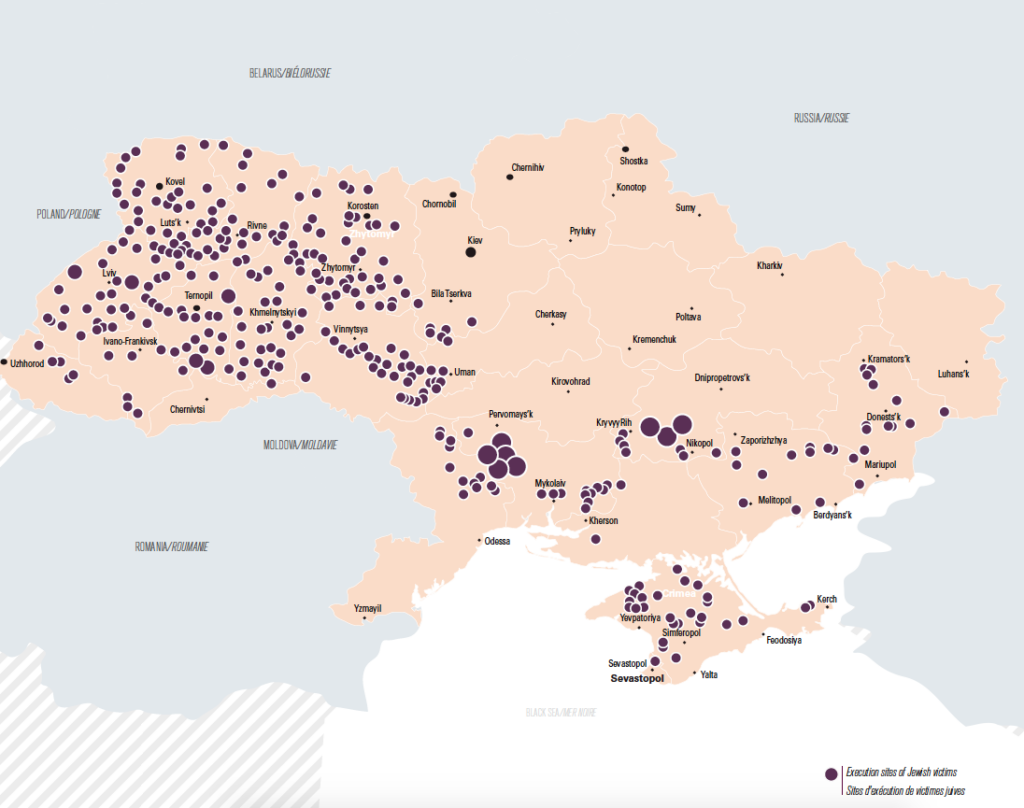The Holocaust was one of the most tragic and deadly chapters of human history. At a time when the last survivors of the Holocaust are passing, and knowledge remains limited, it is our moral responsibility to remember, learn, and pass on stories to future generations.
Outside Ukraine and even inside the country, among younger generation, little is known about Ukraine’s horrific Holocaust history. Some have heard the stories of the most infamous mass grave, Babyn Yar in Kiev, but few realize that Ukraine is filled with thousands of mass graves.
In the Soviet Union, the topic of Holocaust was not something widely promoted; on the contrary, it was often rolled into the common thread of civilian suffering during the WWII. It is not a coincidence that a memorial which finally was built in Kyiv after decades of petitions and public rallies of Jewish community in the 70th on the spot where 60 thousand people had been murdered depicted a communist shielding a group of women and elderly from bullets.
Education and commemoration are two powerful tools, essential in ensuring that never again will such a genocide occur. It is our obligation to uncover these stories, commemorate the innocent victims, talk about the Righteous Among the Nations, and teach all generations across the globe to cement the notion that this history must not repeat itself.
The “Holocaust by bullets”
On the eve of the invasion of the Soviet Union by German troops, 2.5 million Jews lived in the territory of present-day Ukraine. It was the largest community living in the USSR.
Following Operation Barbarossa, the Ukrainian territory was divided into 3 administrative and territorial units: the General Government, the Reichkommissariat Ukraine, the military administration; as well as the Romanian sub-administration for a southern part of the country.
From the first days of the occupation, massacres of the Jewish population began: leaders and public community figures, rabbis, and communists were killed. The first victims of these troops were typically men, while the rest of the Jewish population in the towns and villages were gathered in ghettos where hunger, fear and epidemic reigned. But, beginning in August 1941, Jewish women and children were no longer spared. On August 27, 28 and 29, 23,600 Jews—men, women and children—mostly originating from Transcarpathian Hungary, were exterminated near the town of Kamenets-Podolski. In Kiev, on September 29-30, 1941, the entire Jewish population of the town was shot at the edge of the Babi Yar ravine. Between Christmas and the New Year of 1941-1942, about 50,000 Jews from the town of Odessa and from the region were killed in Bogdanovka.
In the Ukrainian territory, the Jews were imprisoned in ghettos or in forced labor camps, deported to death camps farther west or directly shot on the spot in mass graves, mines, wells, and ravines. More than 1.5 million Ukrainian Jews were exterminated by the Nazis and their collaborators between 1941 and 1944.
Yahad-In Unum began its research in the Ukraine in 2004. In the past 10 years of work, Yahad-In Unum research teams have interviewed 2,203 witnesses and have identified in 916 mass graves in the country. (Source: Yahad-in-Unum)

Other modern genocides in Ukraine
Genocide of Ukrainians
in 1932-33
Forced deportation of Crimean Tatars, indigenous people of the Crimean peninsula in 1944
The map below shows the movements of the Einsatzgruppen units A, B, C and D in Eastern Europe and the respective number of victims that each unit killed between 1941-1942. It is important to note that this map shows only a group of the victims of the Jews in the Soviet Union as mass shootings continued from 1941-1944 and were also carried out by other Nazi units, including police battalions, the Waffen-SS, the Wehrmacht, and local auxiliaries (source Yahad-in-Unum).

Babyn Yar
On September 29, 1941, on the eve of Yom Kippur, almost 34,000 Jewish citizens of Kyiv, Ukraine were forcibly rounded up and shot over two days at Babyn Yar, a ravine then on the outskirts of the city. More Jews were murdered in those two days than in any other single German massacre. Babyn Yar has since become a symbol of the “Holocaust by bullets” – shorthand for the mass shootings carried out in Eastern Europe that claimed the lives of over one-third of the victims of the Holocaust.
Almost eighty years have passed since the tragedy at Babyn Yar. Babyn Yar was not forgotten, but in the USSR its memory was discouraged and intentionally distorted. The truth about the disappearance of the bright, vibrant world of pre-war Kyiv did not meet the ideological tasks of the Soviet regime.
Now, in Ukraine that has gained true independence, it has become possible to revive this memory.
To learn more, visit the “BABYN YAR Holocaust memorial Center” website.
There is a fitting saying in the Talmud: ”Whoever saves one life — saves the entire world”. This quote became a mantra for those who risked their lives to save Jews during the Holocaust. Later, Israel bestowed these people with the title of the Righteous Among the Nations. In Ukraine, over 2.5 thousand people have received this honor. Ukraine ranks 4th in the world by the number of Righteous after Poland, France and Holland.
Jews in Ukraine
At the eve of the twentieth century, the immense majority of the Russian Empire’s 5 400 000 Jews lived in the “Residence Zone” (mainly in Ukraine, but also Belarus, Lithuania and a part of Poland). They spoke Russian, German, Polish and above all Yiddish, and were united by the same culture, even if a large number of them had turned away from religion, becoming involved in the political and social struggle. Despite continuous changes in sovereignty, the Jews felt they belonged more to a region, town or shtetl rather than a specific country. Continue reading here.